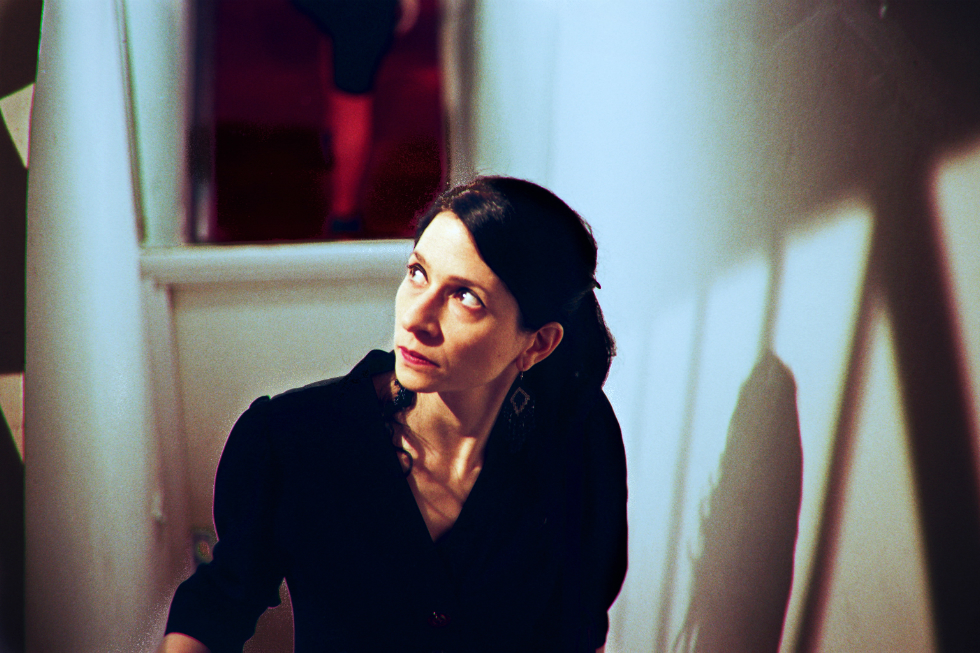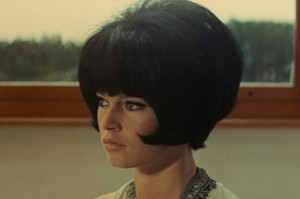“A Truly Remarkable Film”
Female Human Animal

Inspired by surrealist Leonora Carrington, and shot partly during the install for the Tate exhibition in her name, Mike Pinnington delves into the uncanny world of Female Human Animal…
Both inspired and haunted by the twentieth century surrealist Leonora Carrington (1917–2011), what a truly remarkable film Josh Appignanesi’s Female Human Animal is. Shot on VHS, practically impossible to categorise and made almost entirely with non-actors playing doppelgänger versions of themselves, this is film as anti-box office, almost obstinately so – and all the better for it. It follows the travails of novelist and writer Chloe Aridjis (who knew Carrington when they each lived in Mexico), as she works on the install for a show dedicated to the artist that she is co-curating at Tate Liverpool. It is equal parts documentary, satire – of both the artworld and, perhaps, romantic love – psycho-drama, and a determinedly lo-fi documentary portrait of both women.
Speaking to Appignanesi earlier this year, I asked him about the unique feel of the project. “It really was quite a surrealist way to work,” he says, describing it as “social surrealism.” That is to say, “using reality but approaching it in an intuition led, unscripted, royal road to the unconscious kind of way… and working that way meant that key resonances found their way into the film unconsciously in totally unpredictable ways.” Such resonances as between Carrington’s story (which, if you don’t know it, is worth reading up on) and “our quasi-fictive Chloe – which we then, on reviewing footage, built on and added to more consciously. [It was] very liberating!” Full disclosure: at the time of filming, I worked at Tate Liverpool. Fascinated by the idea a film was being shot there without my ever realising it, I asked Appignanesi how it came about – what the circumstances were for the film’s coming into being.
“The project grew organically from a friendship with Chloe Aridjis. In so far as you know them well, the people you’re close to are potentially the most interesting people you could hope to make a film about. But how do you dig into the inner life, which isn’t readily observable by a camera? Maybe you have to act it out. It started with this idea of an experiment in that manner – and then when it turned out Chloe was curating the Carrington Show at Tate Liverpool, I thought ‘OK, this is the backbone and the visual basis for something that could really live.’”
The result is somehow fluid, but (seemingly intentionally) stilted and awkward at the same time. This, it turns out, was achieved very organically: “We shot a bit and then a bit more and it seemed to work, and it just got bigger. There was always a big idea, a feature idea, but we needed to proceed in bits, using real life events as leaping off points for what it might become. It’s a fantastic, delightful way to work; no script (at first), just responding to reality, seeing what it offers towards something more fantasised, and building those bits in. It’s a surrealist mode of working, I guess, and Carrington’s influence must have been there more than we perhaps even realised from the start. Not thinking too much, but working by immersion.”

Some of my ex-colleagues (assistant curator and artistic director no less) appeared in the exhibition install and opening night scenes of Female Human Animal. How, I wondered, was it directing gallery staff? “When you work with non-actors you just try to make the situation as real as possible. Most of the cast are non-actors playing versions of themselves, in some cases very exaggerated versions, in others (like the staff) less so. I don’t think there’s a strong line between documentary and fiction; both are lived, both are curated… I think works that cross that border are very ‘now’ and fertile for a host of reasons to do with our times.”
Watching the film for the second time earlier this week, vaguely formed thoughts I had on first viewing about its wider relationship with surrealism, were not so much confirmed as hammered home. It pulsates, intentionally or otherwise, with the spirit of the movement formally founded by André Breton (with the publication of his Surrealist Manifesto) in 1924. His most famous book, 1928’s Nadja, even more so; Nadja recounts Breton’s pursuit of and serendipitous encounters with a young woman in whom he recognised the defining characteristics of the movement he led. Like Female Human Animal, it is quasi-autobiographical, populated by real life characters in real life situations and locations (although Nadja herself is pseudonymous).
Like Nadja – and surrealism more broadly – it is shot through with the demi-monde, and hints of another world (one populated with Carrington’s strangely allegorical hybrid characters) that, if we want it, is within reach. A recurring motif employed here is of plastic sheeting – whether in the form of protective coverings over artworks, a shower curtain, or a transparent plastic rain coat worn by Aridjis. The suggestion being that these are but flimsy membranes by which one can gain access to another realm; one which is the same, but also different. As an aside, a common thread in Carrington’s work, by the way, was the depiction of our world above ground, and the one we can’t see below us.
Although not a traditional romance film, its press materials described it as: “a darkly romantic fantasia [which tells the story] of a woman who goes beyond societal norms, putting on screen the lurid unconscious of our new sexual politics”. I wondered whose idea this aspect of the film was, how this thread found its way into the narrative. “It came out of conversations [between me and Chloe] about the darkness of one’s hidden desires, the perverse destructive logic of so-called ‘straightness’, of heteronormative romance. We’ve all internalised some of that, women as well as men, so how do you bring that out for the screen, enact it? Once that idea was in play, I ended up pulling on people who’ve done that really well: Chabrol, Hitchcock, Varda.”

On reflection, Female Human Animal is at least in-part a 2018 response to a modernist movement historically beset by a hierarchy that resolutely placed man as artist, woman as muse (hence the likes of Carrington only being truly recognised and celebrated now). Breton’s book recounts his pursuit and ultimate discarding of Nadja – all the while attempting to position his treatment of her as somehow noble. A not dissimilar pursuit occurs in Female Human Animal, beginning when Aridjis spots a man in the gallery during the exhibition’s install. Here, though, it is Aridjis – wisely or otherwise – who does the chasing. And, at pains not to reveal any plot twists, absolutely has the final say in their dalliance.
When I put it to the director that it chimes closely with Breton’s Nadja his reply, fascinatingly, was that he wasn’t aware of the book, despite the weird mirroring between the texts separated by time and geography. But surrealism permeates this film, so perhaps it isn’t a surprise that some of Breton’s opus makes its uncanny presence felt here by osmosis alone. Female Human Animal is spliced with documentary footage of Carrington at key junctures. In one such interlude (and as if to prove my point) she states: “I think, to a great degree, we are manipulated by forces over which we have no control.”
Mike Pinnington
Female Human Animal is currently available to stream on MUBI





